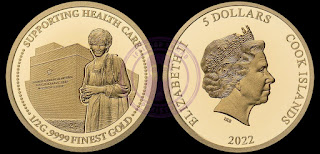A blog celebrating Pakistan’s journey through coins, stamps, and banknotes — from 1947 to today.


Friday, December 31, 2021
Saturday, December 25, 2021
Picture of Muhammad Ali Jinnah on Stamps, Coins and Currency Notes
Although Muhammad Ali Jinnah during his life did not like to put picture of himself or anyone else on Stamps, Coins and Banknotes, but after his death Government of Pakistan decided to put his picture on Rs. 100 banknote in 1957 and from then this trend follows and his picture was used on Stamps and Coins as well.
STAMPS
 |
BANKNOTES
When Pakistan's currency note first published a picture of founder of Pakistan
On 24th of December 1957 the State Bank of Pakistan for the first time issued a currency note worth Rs. 100 with a picture of founder of Pakistan Muhammad Ali Jinnah printed on it. On the reverse side of this green currency note was the image of Badshahi Mosque Lahore.
There was also a strong reaction from scholars and others after the issue of this currency note with a picture of Muhammad Ali Jinnah.
The first news of this series was published in the Daily Jang (Urdu) on December 30th, 1957.
President of the central Jamiat Ulema-e-Pakistan Maulana Abdul Hamid Badauni strongly Protested and said that during the life of Muhammad Ali Jinnah problem arose on publishing his picture on a postage Ticket and he disliked the process. According to him, the founder of Pakistan had considered it appropriate in his life to give a picture of the moon star or a famous Pakistani building on stamps.
Similarly, All Pakistan Constitution Party President Maulana Asad-ul-Qadri appealed to all 'Islamist people' to boycott currency notes with a picture of founder Pakistan to force the authorities to withdraw the notes issued.
He termed the government's move as an insult to Muslim sentiments and said it was a "very non-Islamic way" He appealed to President Iskandar Mirza and finance minister to withdraw the notes while respecting the sentiments of the people.
The same news also published a statement by Maulana Mufti Muhammad Shafi, Vice President, Central Jamiat Ulema-e-Islam, in which he said that on the occasion of the birth anniversary of the founder of Pakistan on December 25th, a new Rs 100 note has been introduced in the markets with a picture of Muhammad Ali Jinnah and is being described as a reminder of the founder of Pakistan. "It is very sad to say that Quaid-i-Azam and Pakistan are now a victim at the hands of ignorant friends or wise enemies that each of his monuments is being selectively erased and ironically all this is being done in his name.‘
According to Maulana Mufti Muhammad Shafi, the founder of Pakistan was the master of the democratic system in his nature and was doing everything possible to establish the system in Pakistan. It is those who call him 'Quaid-i-Azam' who have bricked the brick of democracy in ten years, our Parliament and government have become a haven of conspiracies.
In his statement, he said, "One of the great virtues of Quaid-i-Azam's was that he did not like to put a picture of himself or anyone else on a Pakistani coin, but when someone proposed it to him, he strongly rejected it, which was very wise and in accordance with the teachings of Islam.
During his life and even after that this sunnah hasana remained intact, but today on his birthday, the same Quaid-i-Azam's fans finally sent this away and printed a picture of Quaid-i-Azam on a new 100 rupees note as if they had done great service to Quaid-i-Azam and Pakistan. ‘
According to a report published in December 1957, leaders of eight different religious and other parties of Sargodha said in a joint statement that the State Bank of Pakistan's new proposal to print pictures on Pakistani notes is totally against the guidelines of the Constitution of Pakistan and its spirit, even though Pakistani authorities have taken an oath of loyalty to the Constitution, we would have strongly protested the proposal. And the Governor calls on the State Bank of Pakistan and the Government of Pakistan not to implement a proposal that would allow the practice of printing a picture of an individual on Pakistani notes and coins.
At the same time, newspapers also published communications of readers, with some readers supporting the protests by scholars, while others described the State Bank's move as commendable.
Despite the protests by scholars, the matter cooled down within a few days and the series, which started with 100 rupees currency notes, expanded to other notes and all notes worth Rs 5 and above began to publish a picture of founder of Pakistan.
It will not be mentioned here that on 3rd October 1947, Bahawalpur state issued a stamp on which pictures of founder of Pakistan Muhammad Ali Jinnah and Ameer of Bahawalpur Sir Sadiq Muhammad Khan Abbasi were published.
It was the first postage stamp in the world on which a photograph of Muhammad Ali Jinnah was published. On Pakistan stamps the picture was formally published for the first time on December 25th, 1966. It was a set of two stamps worth 15 and 50 Paisas.
First commemorative coins with the picture of Muhamamd Ali Jinnah were issued on December 22nd, 1976 in the denominations of 50 Paisas, 100 Rupees and 500 Rupees.
First circulating coin with the picture of Muhamamd Ali Jinnah was issued in 1998 in the denomination of 1 Rupee.
CourtesyAqeel Abbas Jafferi
BBC Urdu
Monday, November 15, 2021
Pakistan related World Coins





































































